A spider plant is an excellent houseplant for beginners. Spider plants are perfect for beginners because they are inexpensive and easy to care for. They are also very attractive and add a touch of elegance to any room.
The spider plant actually has very little to do with spiders. It does not attract them more than any other houseplant might or provide a home for spiders, but gets its name due to its long wiry leaves and stems.
Spider plants are easy to care for and require minimal maintenance. They are drought tolerant and thrive in low light conditions. They are also very easy to grow indoors with proper spider plant maintenance and care.
Spider Plant Overview
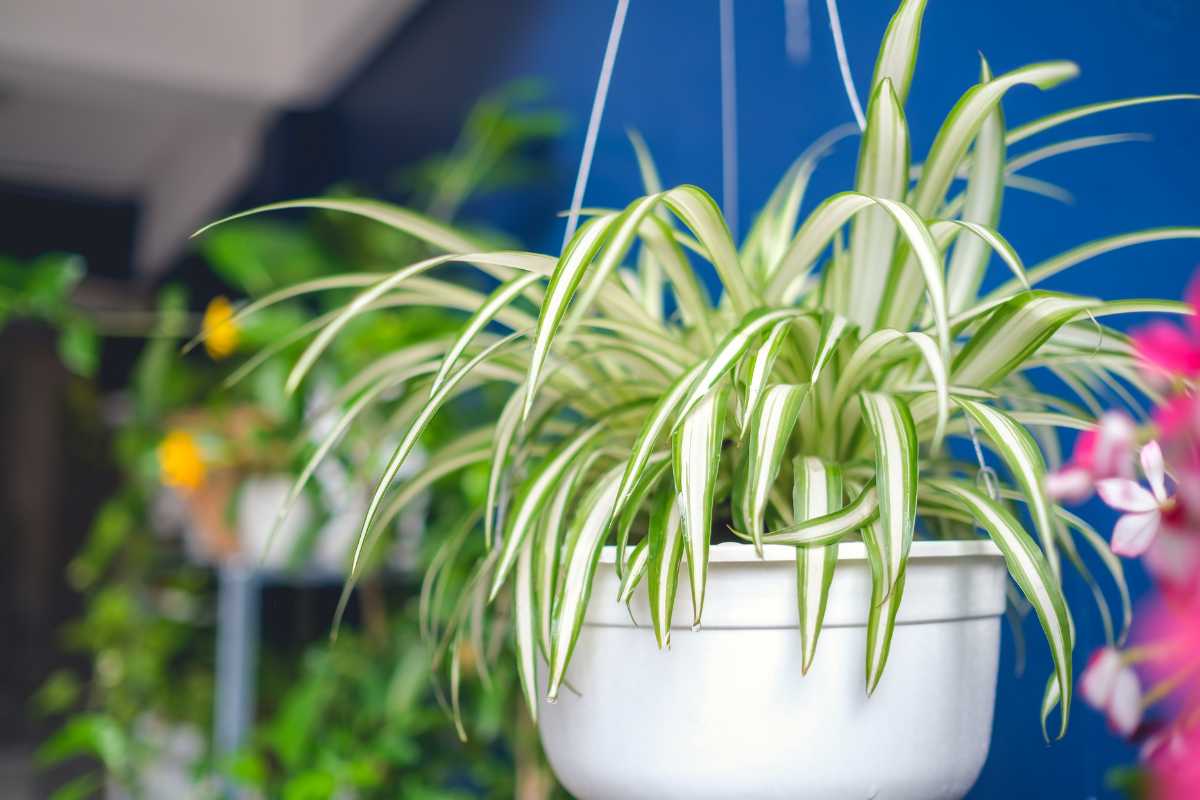
Originally from South Africa, the spider plant is botanically known as Chlorophytum comosum. Common popular names include airplane plant, ribbon plant, spider ivy, and Bernard’s lily.
The spider plant is an herbaceous perennial that belongs to the Asparagaceae family and is an incredibly popular houseplant. It’s a hardy plant and will prosper in conditions even when they are not ideal. If these plants are well cared for, they are a stunning addition to any home or office.
Their slender, arching leaves can grow up to 1.5 feet in length and will be either all green, or green and white striped. Mature spider plants will grow longish stems with petite flowers that are shaped like stars.
- Read more about What Do Spider Plant Flowers Look Like.
When the blooms die, little plantlets form in their place. These plantlets will grow their own roots. Spider plants can be cultivated at any time of year. However, they must not be exposed to frost.
Spider plants are often cultivated as hanging plants since their leaves will cascade downward as they grow together with their long stems and hanging plantlets. They can also be positioned on shelves, atop furniture, or columns, so that the plants can develop their downward cascade.
If you position it on top of something, take care that the plant leaves hang free and are not crushed underneath the pot. Also, pay attention to the weight of developing stems with plantlets, so that they don’t become so heavy that the stems pull the plant container over or even off the shelf.
Remembering to water your spider plant will be your biggest challenge, together with feeding it during the growing season. In warmer climates, these plants do exceptionally well when grown outdoors with proper care.
There are well over two hundred varieties of spider plants. Some of the most popular varieties include:
- Chlorophytum comosum “Bonnie” – This variety is a compact version and has leaves that loosely curl. The leaf is characterized by a beige stripe down the middle with green margins. The blooms are yellow.
- Chlorophytum comosum “Variegatum”– This spider plant has a green stripe down the middle with cream-colored edges on either side. It has long stems, that are green
- Chlorophytum comosum “Vittatum” – The Vittatum has leaves with a white stripe down the center and green sides that are medium in color. Stems will be long and white.
The Spider Plant Care Guide
Soil for the Spider Plant
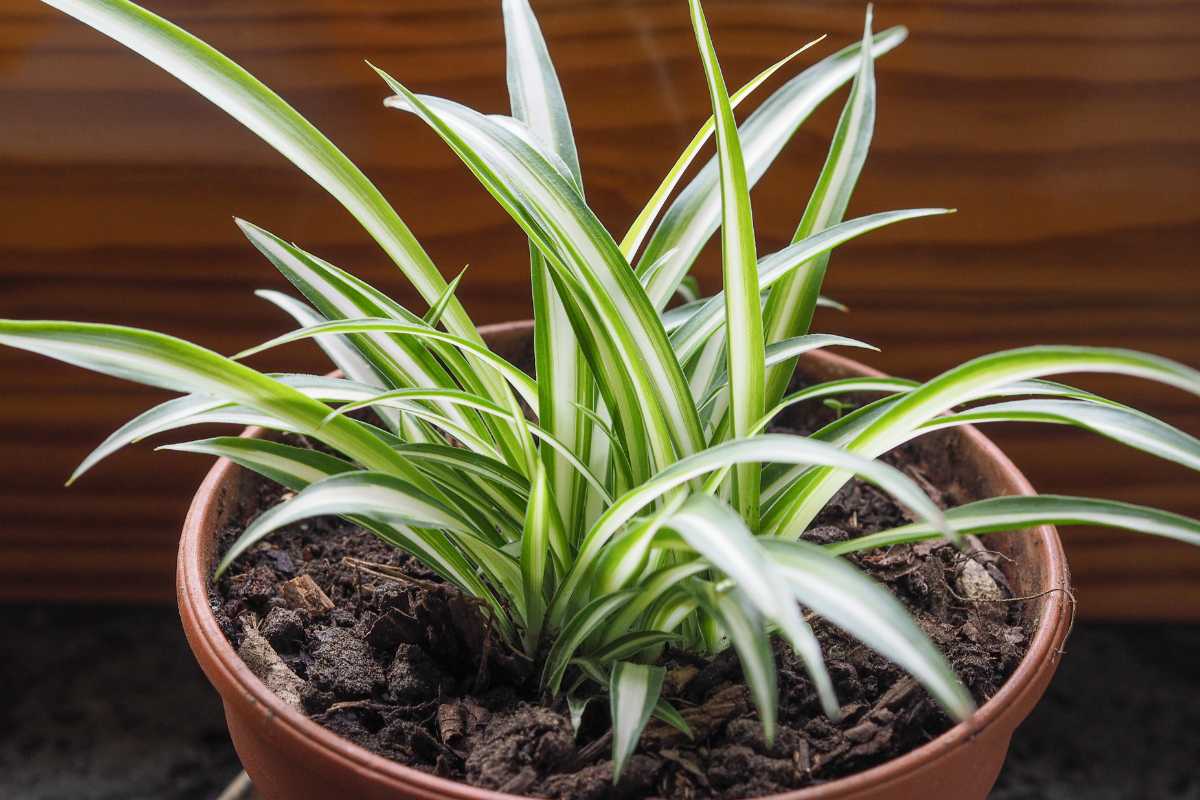
A spider plant can thrive in various soil types. It prefers a soil bed that contains loose, loamy, and well-draining soil. Drainage is incredibly important.
The pH level should sit ideally between 6.0 and 7.2 pH. They like when the soil pH is relatively neutral, but they will do well in soil that is slightly acidic soil to slightly alkaline.
Make sure to keep the spider plant soil moist for healthy growth. If the soil bed has a high level of salt, the leaf tips may turn brown.
When grown outdoors in a garden bed, they will need at least three feet of room for growth.
- Discover more in-depth about Soil for Spider Plant.
Best Temperature for the Spider Plant
When caring for spider plants, ideal climate conditions for a spider plant are warm and humid.
Preferred daytime temperatures should rest between 65° F and 85°F. Temperatures at night should sit between 50°F and 55°F. You will want to prevent temperatures from falling below 50° Fahrenheit.
They need to be protected from cold drafts and especially air conditioning vents as well as heaters.
How Much Light Does a Spider Plant Need?
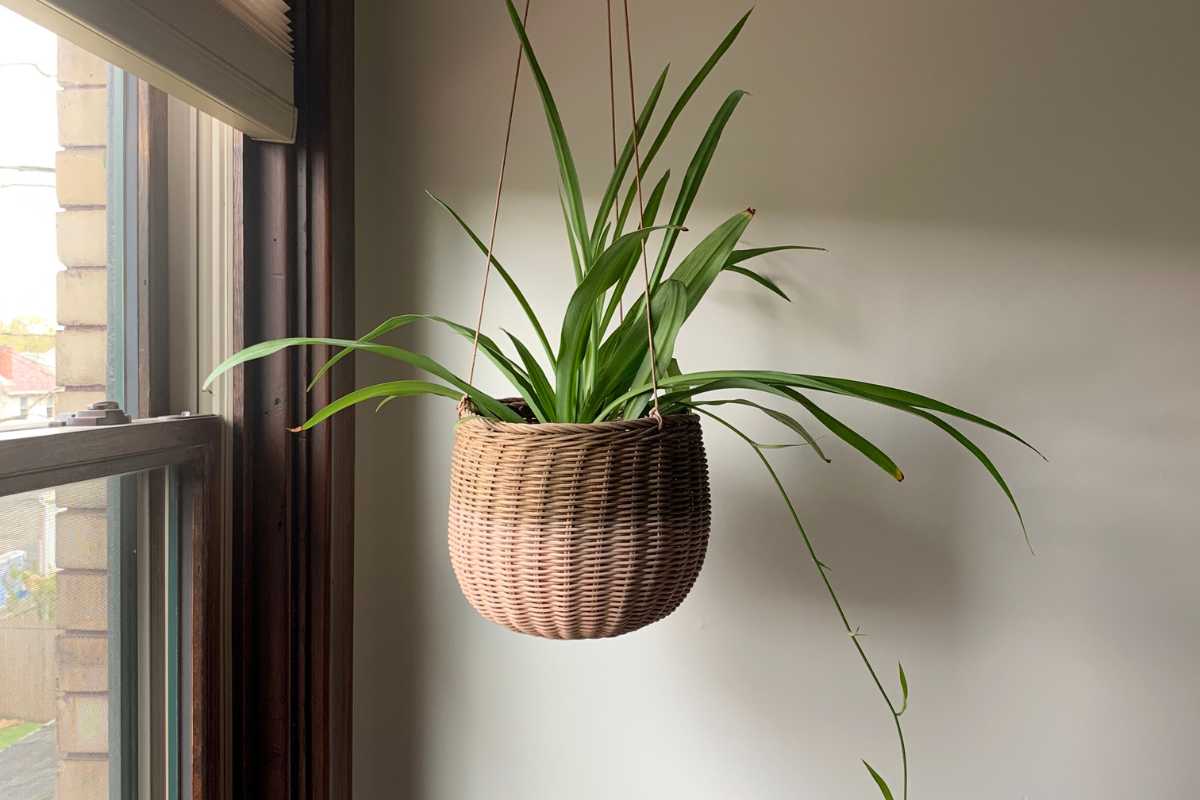
Ah, the question of light – how much light do spider plants need.
The spider plant, while adaptable, does have its preferences when it comes to lighting conditions. Let’s delve into the nuances of indoor and outdoor light requirements for the spider plant.
Indoors first. Spider plants prefer bright, indirect light when they are kept inside. Placing the plant near a north or east-facing window would be ideal.
They can tolerate lower light conditions, but their growth may slow, and their vibrant variegation may fade. The leaves will start to droop as well.
On the flip side, too much direct sunlight can scorch their leaves, leaving them with unsightly brown tips and yellow stripes.
When it comes to outdoor living, the game changes a little. Spider plants can thrive outside, but they need a spot that offers some shade from the harshest rays of the sun. Think dappled sunlight, like under a tree or a pergola. This way, they get the light they need without the risk of sunburn.
- Learn more about Spider Plant Light Requirements
Remember, the spider plant is a native of the forest floor in tropical regions. It’s accustomed to receiving filtered light, with the sun’s rays softened by the canopy above. Try to replicate these conditions, whether indoors or outdoors, and your spider plant will be content.
It’s always a good idea to keep an eye on your plant’s response to its light conditions. If you notice your plant’s leaves losing their color or becoming scorched at the tips, it may be getting too much direct sunlight.
Conversely, if your plant’s growth seems to slow significantly or its leaves start to elongate or lose their fullness, it might be craving more light.
In essence, providing the right amount of light for your spider plant is about striking a balance. Not too little, not too much, but just right. With a bit of observation and care, you’ll find the sweet spot that keeps your spider plant thriving.
Water and Humidity for the Spider Plant
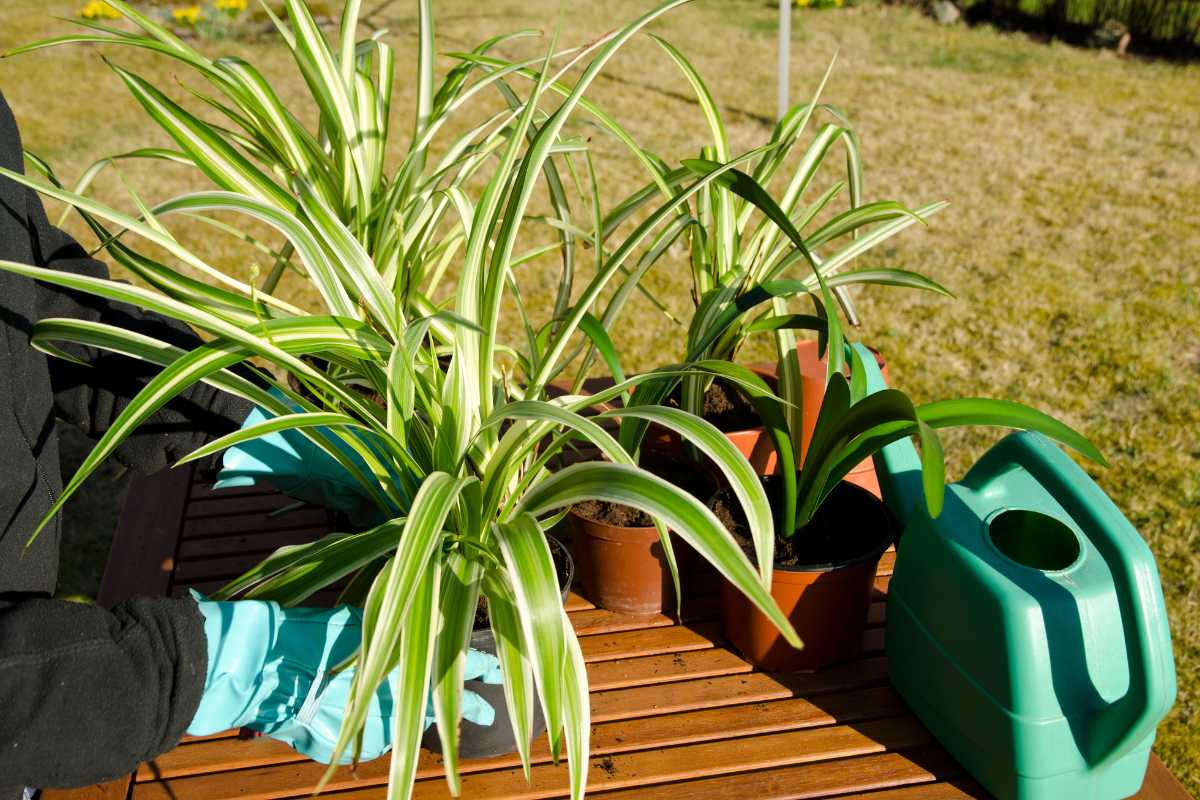
Like most indoor plants, spider plants prefer moist soil, but not soggy or waterlogged. It is important not to overwater, as this can lead to root rot and kill the plant.
Spider plants are sensitive to both fluoride and to chlorine that’s common in tap water. Fluoride and chlorine can cause brown leaf tips. If your city has high levels of chlorinated water, it would be better to use collected rainwater or distilled water for indoor plants.
Another option is to leave out a bucket of the tap water overnight to allow the fluoride and chlorine levels to decrease before watering.
During the initial period of growth for a baby spider plant (spiderette), water occasionally. Once the plant has fully developed, it should be watered moderately. Particularly in the spring and summer seasons, make sure the soil remains moist to stimulate growth. The soil should not dry out completely.
Leaf tips may also turn brown if the humidity is too low. Regular misting will help your plant if you don’t run a humidifier or if you have a particularly dry home or office environment. If you like the idea of having a plant in your bathroom, steamy bathrooms are well-loved by the spider plant thanks to the higher levels of humidity.
Learn more about how to water in this Spider Plant Watering Guide.
How to Fertilize the Spider Plant
Fertilizing is the way to show your love to the spider plant. First things first, you need to know when to fertilize. Spider plants are not voracious eaters, but they do appreciate a good meal during their growth season.
From the budding days of spring till the warm touch of early fall, that’s your window. That’s when your plant is in its element, growing with gusto.
These plants should be fertilized during the spring and summer months as much as twice a month.
Ah, but what to feed them? You might ask. A balanced houseplant fertilizer, preferably with a ratio of 10-10-10. That’s equal parts nitrogen, phosphorus, and potassium (NPK) – the perfect concoction to support the overall health and vigor of your plant.
But here’s the catch: dilution is key. Mix your chosen fertilizer for spider plants with water according to the package instructions. Then, dilute it further, to half its recommended strength.
Spider plants can be sensitive and a strong, too potent dose might singe their roots. It’s easier to add more fertilizer if needed.
Now comes the moment of truth – the actual application. Make it a point to moisten the soil before you add the fertilizer. This will protect the roots from a direct hit of nutrients, ensuring they absorb the goodness gradually and effectively.
Remember to observe your plant’s response, adjusting your regimen as needed. A bit of trial and error is part of the journey.
Moderate fertilization can be good for spider plants. Too much, and leaf tips will turn brown, whereas too little will produce weak growth. Water-soluble fertilizer is ideal, but granular fertilizer can work as well.
In the end, it’s about maintaining a balance. Too little nutrition, and your plant may languish; too much, and it might recoil. Striking the right chord might take time, but it’ll be worth it.
Learn more about Fertilizer for Spider Plant in this guide.
Pruning and Repotting the Spider Plant

Spider plants can grow as large as three feet in diameter as well as in length. You can prune some leaves at the base of the plant, as it will not hurt or damage your plant.
Pruning in the springtime will help keep the size of your plant manageable and stimulate growth. Also, some pups can be removed. The more spiderettes your plant produces, the more water and fertilizer it will require.
To prune at the base of the plant, use a sharp pair of scissors to remove any diseased or discolored leaves. To remove the pups, cut the long stems all the way back to the base in both the parent plant and the baby plant.
Thinning your spider plant should also be considered. Since spider plants form crowded mounds of leaves, thinning can help to avoid overcrowding and die-out. Thinning will permit the main plant to have room for expansion and stimulate new growth.
Pups will appear when the plant is mature and when it is a bit root-bound. If you constantly thin your plant, it most likely will not produce plantlets.
Learning how to trim spider plants will help with keeping them happy and healthy.
When you repot, it may also be wise to trim the roots. A good pruning of the roots should be done every year or two before repotting it in new soil.
Spider plants should be planted in pots that are slightly bigger than their root balls and should have enough drainage holes to prevent soggy soil. These plants do better in loose, moist potting soil.
Spring is the best period if you need to repot. Remove your spider pot gently from its container and place it in the new container at approximately the same depth. Fill in the larger container with fresh potting soil.
Your spider plant will need to be repotted every two or three years. When roots grow through the drainage holes or up through the soil bed to the surface, you’ll know it’s time to repot.
Learn more in-depth about Spider Plant Repotting.
Propagating the Spider Plant
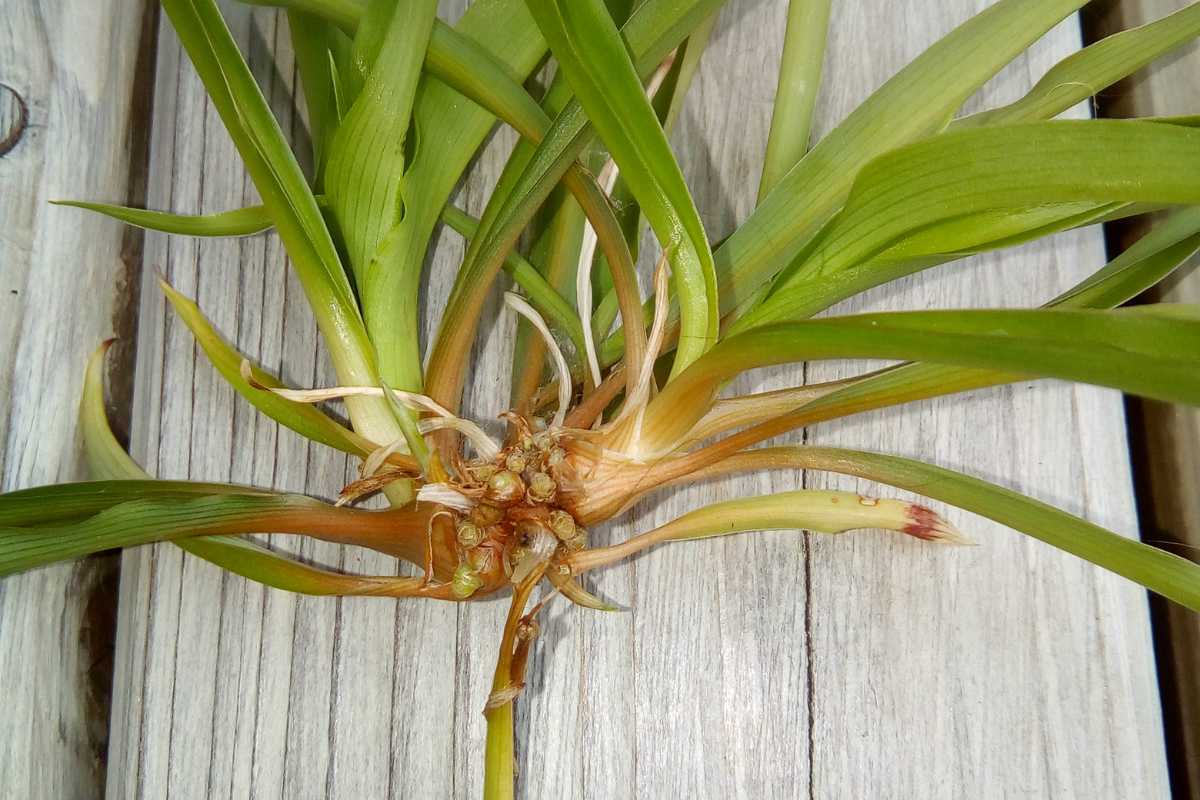
It is easy to propagate your spider plant. Since the plant will grow its own plantlets, simply leave them on their stems until they develop roots. When the roots have developed, you can cut the pup off the stem while leaving the roots intact.
Place them in a new container with loose potting soil and good drainage. The soil must remain moist, but not soggy. The new roots should gradually establish themselves in the soil bed.
An even better way to ensure success is by placing a new pot of soil near the mother plant in such a way that the pups touch the new soil. Ensure that the new soil stays moist. Once the spiderette has rooted into the new pot, you can cut it from the parent plant. Spider pups can also be rooted in water.
Mature plants can be divided. Dig them up gently and pull apart the root ball into two or more sections. The roots should remain intact. Replant the individual sections in individual containers.
How to Care for a Spider Plant in the Winter
Caring for a spider plant during winter months does involve a few particular considerations. As the air cools and the days shorten, your green companion will appreciate a slight shift in its care routine.
Firstly, remember that your spider plant is less active in winter. It’s not quite a hibernation, but it is a period of slower growth. Therefore, your plant will require less water.
Overwatering during winter can lead to root rot, a perilous condition for our beloved plants. Wait until the top inch of the soil is dry before watering again.
Secondly, think about light. The shorter days of winter mean fewer hours of sunlight. Try to position your plant in a spot where it can catch as much of that precious daylight as possible. However, avoid direct sunlight, which can scorch its leaves.
Now, let’s talk temperature. Spider plants prefer cooler conditions, ideally between 55° and 65°F. They can tolerate lower temperatures, but they won’t be happy in freezing cold. Keep your plant away from drafty windows or doors to protect it from chilly winter drafts.
One more thing, spider plants love humidity. But winter air, especially in heated homes, can be dry. Consider grouping your plants together or using a pebble tray with water to increase the humidity around your spider plant.
Lastly, hold off on the fertilizer. Your plant is not in its growth phase, so it won’t need the extra nutrients. Come spring, you can resume your fertilizing routine.
There you go, winter care for your spider plant, in a nutshell. It’s about understanding the needs of your plant and adjusting its environment accordingly. With a little bit of attention and care, your spider plant will not only survive the winter but thrive in it.
Spider Plant Common Plant Pests and Diseases
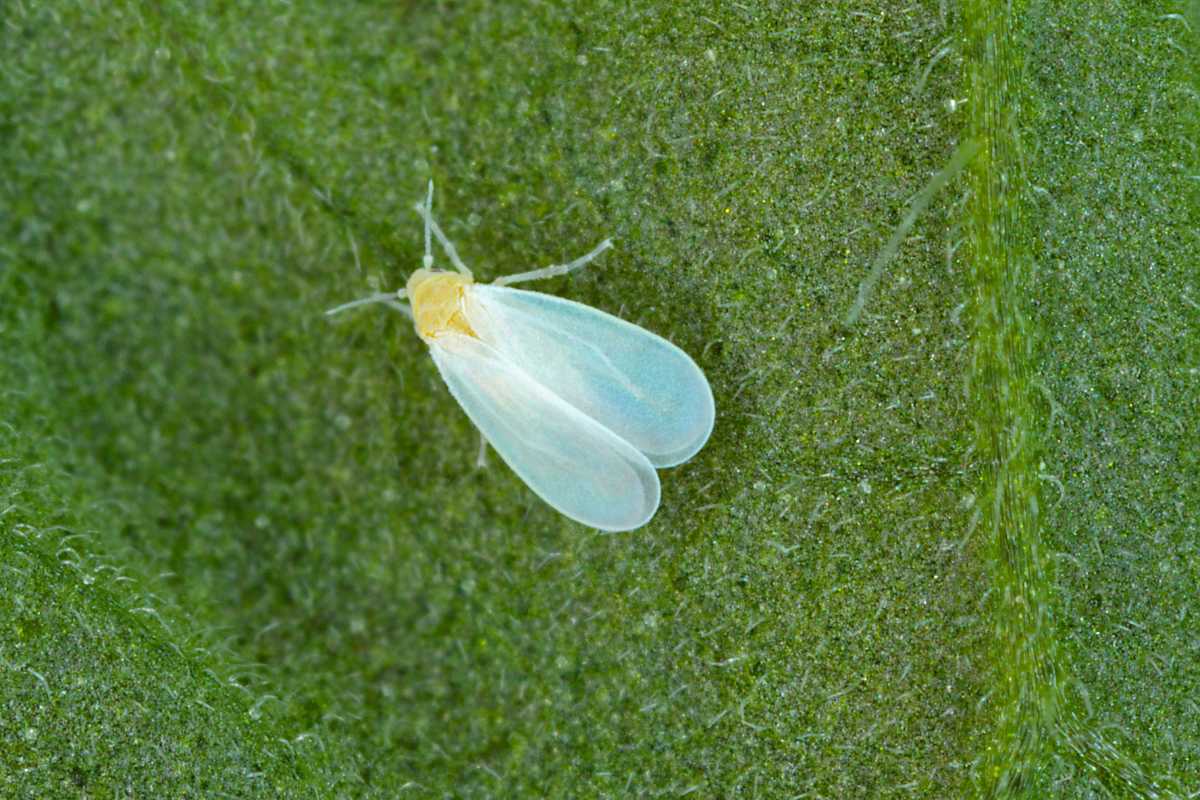
Generally speaking, spider plants are quite healthy. They are subject to pests that are common to many other houseplants such as aphids, spider mites, and whiteflies.
A typical sign of pests on your spider plant will be foliage that looks depreciated and suffering. You may also note tiny black specks on the undersides of leaves and stems. Stunting, curling of leaves, and plant death may indicate an insect infestation.
If, you prefer not to use a chemical insecticide, you can rinse the plant off with water. If the infestation is serious, a pesticide may be necessary. You can check the organic pest control article for organic options.
Because spider plants grow very rapidly, it is easy for this plant to become root-bound. One of the biggest indications of an unhappy spider plant will be brown leaf tips. These can be caused for multiple reasons including low humidity, dry soil, or too much salt or chemical buildup. Cut the brown tips off.
Cleaning the leaves of your spider plant is easy. Simply use a soft dampened cloth to wipe away dust, debris, and pests from the leaves, both tops, and bottoms.
Should you cultivate spider plants in your outdoor garden, remember that they will tend to crowd other plants if there is not some type of barrier between them.
Spider Plants Clean the Air
Spider plants are known to reduce air pollution indoors. So, the addition of a spider plant to your home or office will bring added benefits.
The NASA Clean Air Study determined that the spider plant is one of several air-purifying plants that are great at removing toxins in the air, particularly xylene and formaldehyde.
Spider Plant Toxicity and Pets

Fortunately, this is one popular houseplant that is non-toxic for both cats and dogs, so if they ingest it, they’ll be okay.
Learn more in these Spider Plants and Cats and Spider Plant and Dogs guides.
Growing a Spider Plant Final Thoughts
Like the Pothos, a spider plant is relatively easy to care for with low maintenance, making it ideal for first-time plant owners. These spindly plants will add color, greenery, and texture to your home or office decor.
Long, sword-like arching leaves will be particularly attractive when placed in hanging baskets or perched up high enough to allow downward hanging growth.
If you’re looking for other houseplant guides, here are popular ones:
- Purple Spider Plant (Cleome hassleriana)
- Schefflera Plant Care Guide
- Lucky Bamboo Care Guide
- Kalanchoe Plant Care Guide
- Philodendron Plant Care Guide
Spider Plant Care FAQs
How much sun does a spider plant need?
A spider plant needs bright, indirect sunlight. It’s best not to leave it in direct sunlight as it will lead to scorched leaves.
Is a spider plant indoor or outdoor?
The spider plant is a tropical plant that is a popular indoor plant, but also does well outdoors in warmer climates. Spider plant care indoors is just as easy as spider plant care outdoors. This is one of the easiest plants to care for.
What are the benefits of spider plants?
Spider plants have a number of benefits that go beyond how great they look. They’re easy to take care of and help clean the air in your home. They don’t require a lot of light are good choices for those who live in apartments where space is limited.
How to take care of a spider plant?
You can take care of spider plants by watering it regularly, and keeping it in an area with lots of indirect, bright light. A spider plant doesn’t like cold temperatures, so make sure to bring it inside during winter months.
Do spider plants attract spiders?
The spider plant does not attract spiders more than any other houseplants might or provide a home to spiders. The spider plant is known as the “spider plant” because of its long wiry stems and leaves, and not because they bring spiders.
My spider plant has small brown bumps on the stem. What does this mean?
If the small brown bumps resemble miniature, hard scales, then you’re likely dealing with scale insects. These pesky little creatures are common pests in the world of houseplants, including the usually resilient spider plant. They latch onto your plant’s stems, piercing through the surface to feed on its sap.
I am growing my spider plants in my backyard garden. They are getting too big. What can I do to reduce the size?
If the spider plants are growing too big, trim the outer leaves back, so the plant size is smaller. You can also dig them up and divide the root ball into several smaller plants.
My spider plant has sticky stuff on it. What is it and what should I do about it?
The sticky stuff is probably honeydew from when pests suck the sap from your plant. This will ultimately kill the plant. Pests that cause this may be aphids, scale, or mealybugs. The pests must be eradicated and you can try with a strong spray of water. You can also try neem oil or insecticidal soap to remove honeydew and pests.
Should I cut the brown tips off the spider plant?
Yes, trimming the brown tips off the leaves will benefit the spider plant. If you want to give the trim a nice aesthetic look, make two cuts that meet in the middle and mimic the natural shape of the tips of the leaves.
Sources:


